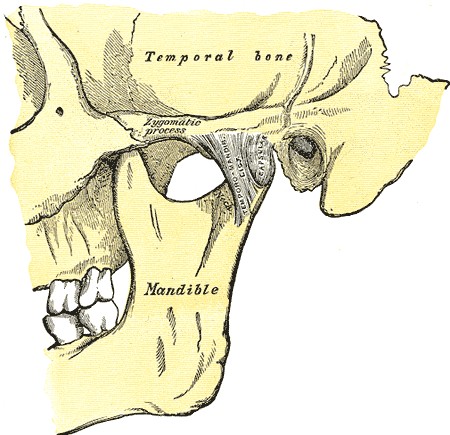Open your jaw all the way and shut it. This simple movement would not be possible without the Temporo-Mandibular Joint (TMJ). It connects the temporal bone (the bone that forms the side of the skull) and the mandible (the lower jaw). Even though it is only a small disc of cartilage, it separates the bones so that the mandible may slide easily whenever you talk, swallow, chew, kiss, etc. Therefore, damage to this complex, triangular structure in front of your ear, can cause considerable discomfort.
You can locate this joint by putting your finger on the triangular structure in front of your ear. Then move your finger just slightly forward and press firmly while you open your jaw all the way and close it. You can also feel the joint motion in your ear canal.
When you bite down hard, you put force on the object between your teeth and on the joint. In terms of physics, the jaw is the lever and the TMJ is the fulcrum. Actually, more force is applied (per square foot) to the joint surface than to whatever is between your teeth because the cartilage between the bones provides a smooth surface, over which the joint can freely slide with minimal friction.
Therefore, the forces of chewing can be distributed over a wider surface in the joint space and minimize the risk of injury. In addition, several muscles contribute to opening and closing the jaw and aid in the function of the TMJ.

In most patients, pain associated with the TMJ is a result of displacement of the cartilage disc that causes pressure and stretching of the associated sensory nerves. The popping or clicking occurs when the disk snaps into place when the jaw moves. In addition, the chewing muscles may spasm, not function efficiently, and cause pain and tenderness.
Causes of TMJ Damage
Symptoms of TMJ Damage
The pain may be sharp and searing, occurring each time you swallow, yawn, talk, or chew, or it may be dull and constant. It hurts over the joint, immediately in front of the ear, but pain can also radiate elsewhere. It often causes spasms in the adjacent muscles that are attached to the bones of the skull, face, and jaws. Then pain can be felt at the side of the head (the temple), the cheek, the lower jaw, and the teeth.
A very common focus of pain is in the ear. Many patients come to the ear specialist quite convinced their pain is from an ear infection. When the earache is not associated with a hearing loss and the eardrum looks normal, the doctor will consider the possibility that the pain comes from TMJ.
There are a few other symptoms besides pain that TMJ can cause. It can make popping, clicking, or grinding sounds when the jaws are opened wide. Or the jaw locks wide open (dislocated). At the other extreme, TMJ can prevent the jaws from opening fully. Some people get ringing in their ears from TMJ.
Because TMJ symptoms often develop in the head and neck, otolaryngologists are appropriately qualified to diagnose TMJ problems. Proper diagnosis of TMJ begins with a detailed history and physical, including careful assessment of the teeth occlusion and function of the jaw joints and muscles. An early diagnosis will likely respond to simple, self-remedies:
In cases of joint injury, apply ice packs soon after the injury to reduce swelling. Relaxation techniques and stress reduction, patient education, non-steroidal anti-inflammatory drugs, muscle relaxants, or other medications may also offer relief.
Other treatments for advanced cases may include fabrication of an occlusal splint to prevent wear and tear on the joint, improving the alignment of the upper and lower teeth, and surgery. After diagnosis, your otolaryngologist may suggest further consultation with your dentist and oral surgeon to facilitate effective management of TMJ pain.